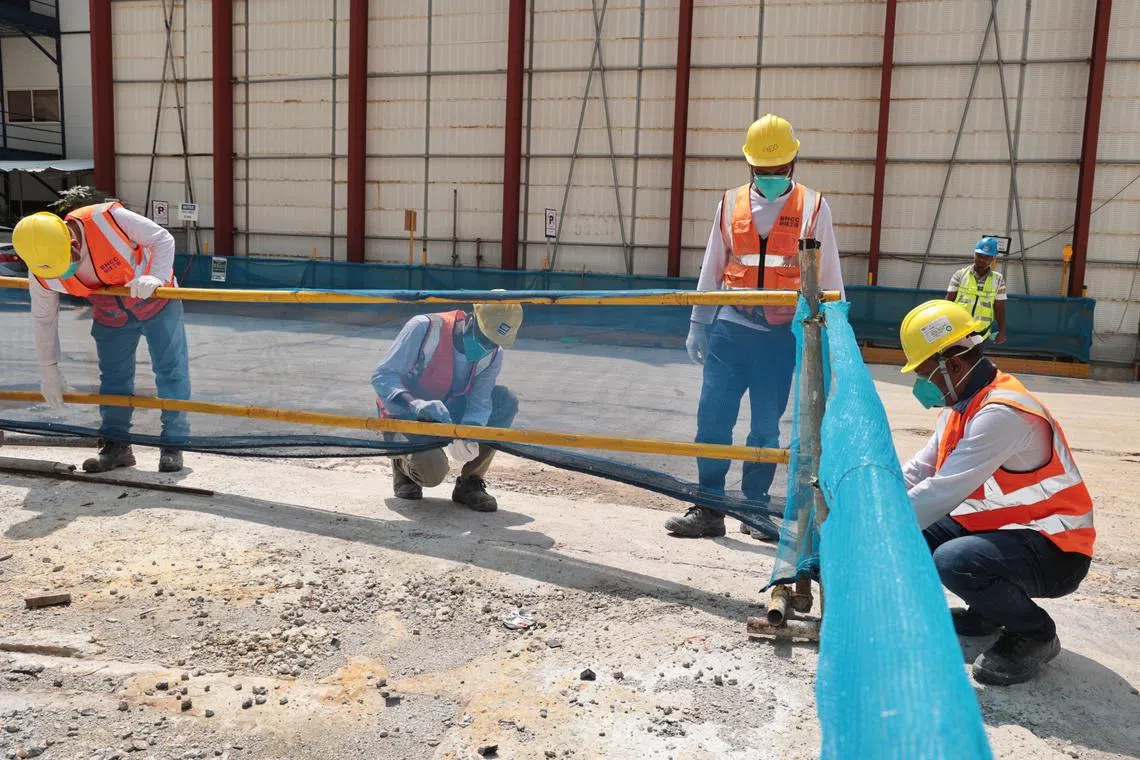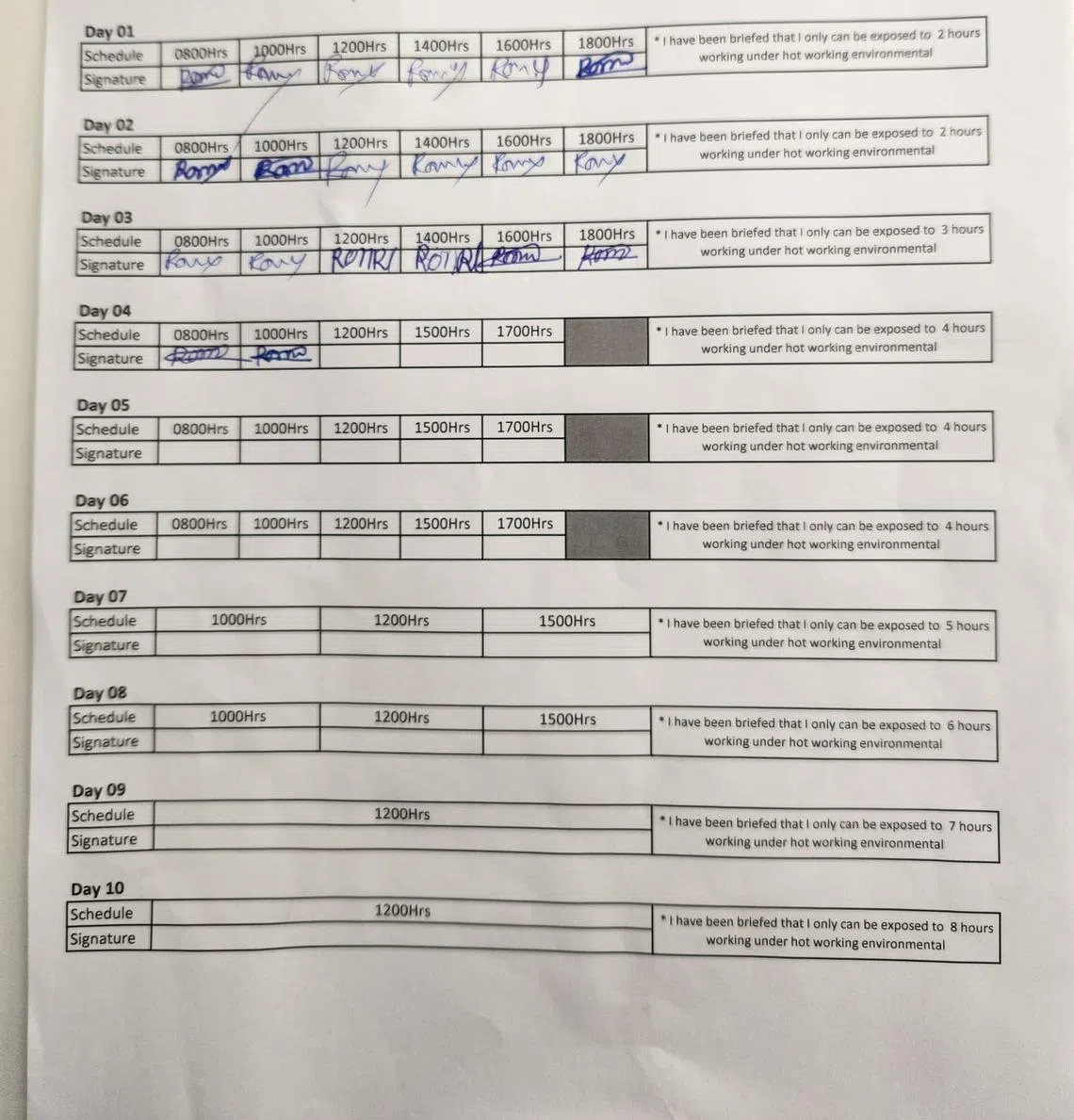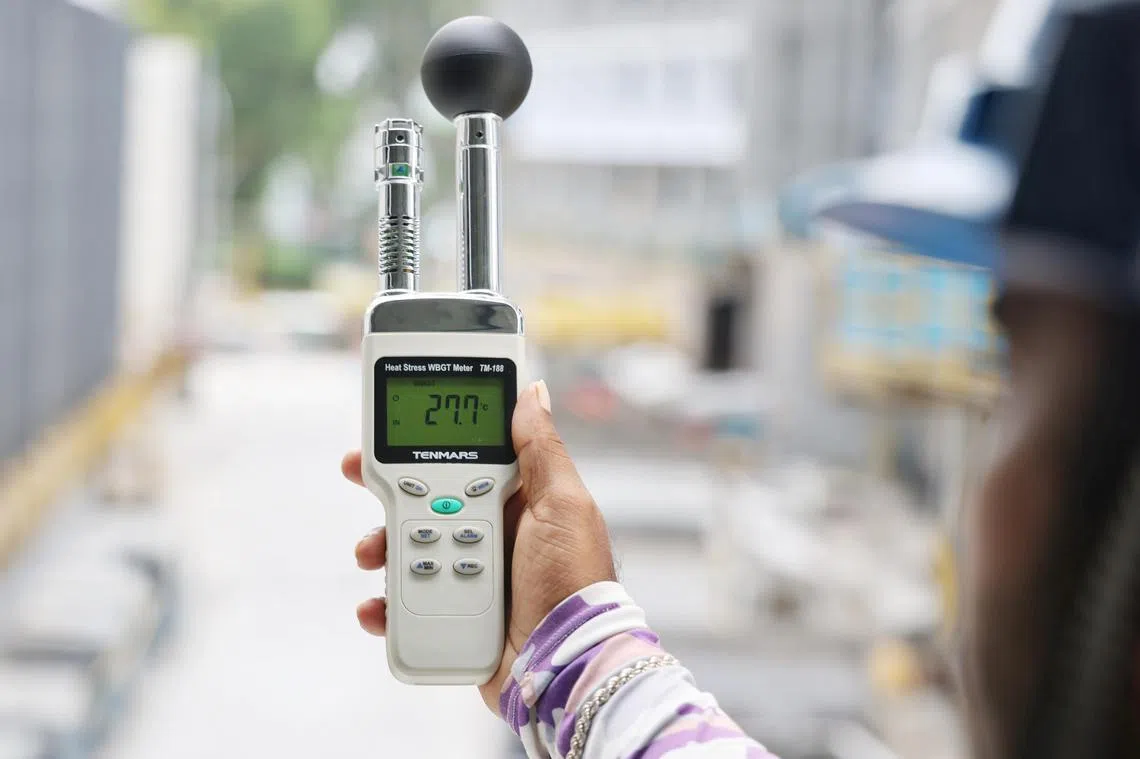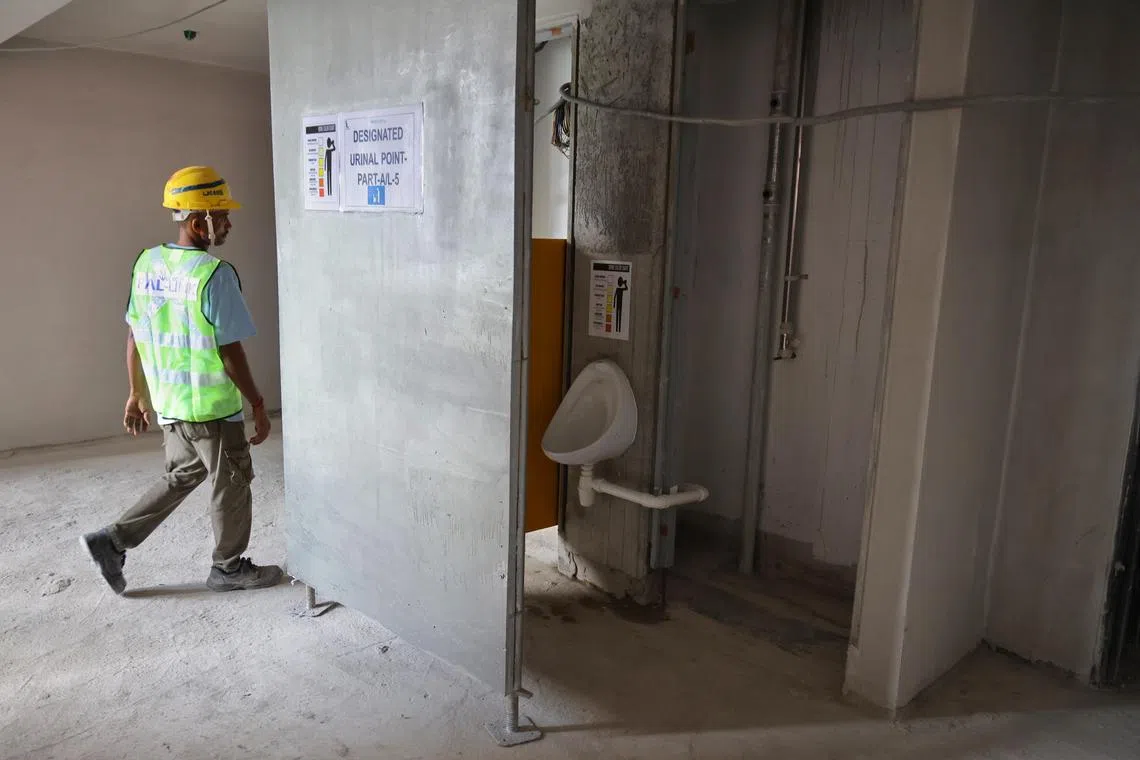Building heat resilience: Helping construction workers adjust to S’pore’s sweltering weather
Sign up now: Get ST's newsletters delivered to your inbox

Mr Liu Liangming (left) and Mr Krishnan Veerabathiran were among the few Pal-Link Construction workers who have undergone heat acclimatisation.
ST PHOTO: JASON QUAH
Follow topic:
SINGAPORE – On Mr Liu Liangming’s first day back at his worksite in May after a three-month break in the temperate climate of his home town in China’s Jiangsu province, his supervisor told him to limit outdoor work to no more than two hours.
This was an unusual instruction for Mr Liu, 52, whose vocation involves constructing the skeleton of Housing Board blocks at a site in Owen Road.
As a formwork worker, he usually works under the sun throughout his eight-hour shift, hoisting steel and wooden beams into a matrix structure, and pouring concrete into moulds.
But on May 15, his first day back, Mr Liu was relieved to be working mostly in the shade, as the sun and humidity felt extra unforgiving after spending three months back in eastern China. During the wintery Chinese New Year period, the temperatures plunged to minus 12 deg C, he said.
“When I first came back, I was not used to the weather. I was sweating a lot more and drank more water, and rested when the heat was too intense,” said Mr Liu in Mandarin.
His employer, Pal-Link Construction, placed him on a two-week programme to help him slowly adjust to the tropical heat and strenuous work.
“Formwork is the most strenuous job on-site. After a long break from work, we needed to get him (adapted) progressively, and do less strenuous work in the shade. That’s how we build up his stamina,” said Mr Lee Meng Shui, a senior project manager at Pal-Link.
March was also the start of the annual hot and dry period until mid-year, with many scorching days that exceeded 35 deg C.
Mr Liu was one of six Pal-Link workers at the Owen Road site who have undergone structured heat acclimatisation since the programme formally started in August 2023.
Previously, the company had some acclimatisation protocols in place for three to four years, but this was not formalised. New workers or those returning from long leave were mainly told not to work overtime and to do mostly housekeeping tasks.
Since 2010, all employers of those who do outdoor work have been required to implement heat acclimatisation protocols, especially for new workers and those returning from prolonged leave or illness. The minimum acclimatisation period is seven days, and enforcement action can be taken, especially if workers from colder climates are not acclimatised.
Pal-Link managing director Roger Teo said it was only about a year ago that the importance of managing heat stress was emphasised in the construction sector. In October 2023, the Ministry of Manpower (MOM) introduced enhanced measures to reduce heat stress for outdoor workers, focusing on acclimatisation, hydration, resting under the shade and education.
Another company, BHCC Construction – which does residential, commercial and industrial projects – has had heat acclimatisation in place since 2018, benefiting over 100 workers.

These BHCC Construction workers, pictured on June 13 at a Woodlands site, were in their first week of acclimatisation. Their outdoor work was kept short and limited to light duties such as fixing barrier nets.
ST PHOTO: HESTER TAN
MOM inspections between March and June found that 78 out of 250 workplaces had breached heat safety rules, such as not giving workers adequate rest breaks under shade for heavy physical work, or not putting them through acclimatisation programmes.
In May, Mr Liu was handed a special work schedule to follow in his first 14 days back at work, and this involved avoiding outdoor work between the hotter hours of noon and 3.30pm in the early days.
On day two, for instance, he did formwork at higher levels between 8am and 10am, and then continued his work under shade, prising the steel and wood support from dried concrete at the lower storeys. After lunch, he stayed in the building’s interior, doing lighter tasks such as laying out kerbs and shaving off concrete remnants.

In their first week of acclimatisation, BHCC Construction workers mostly performed housekeeping duties and cleaning debris under the shade.
ST PHOTO: HESTER TAN
By day 13, he was working seven hours outdoors, with no issue doing physically demanding work such as scaling heights, working with steel and pouring concrete.
Proper heat acclimatisation improves workers’ endurance, which translates to greater productivity, says the Workplace Safety and Health Council’s heat-stress handbook. If Mr Liu had proceeded with his ordinary workload on day one, he could have been a victim of heat illness.
While Mr Liu has been working here for 13 years, a person’s tolerance to heat wears off after two weeks without exposure. Gradually reintroducing a worker to the heat and physical demands will reduce cardiovascular strain and prevent the body from overheating during sweltering periods, an International Labour Organisation (ILO) report in July said.

A sample of an acclimatisation schedule used for BHCC workers.
ST PHOTO: SHABANA BEGUM
Singapore saw a heat-related death in 2020 when a worker succumbed to heatstroke on his first day at work after the two-month Covid-19 circuit breaker. The man, who had a pre-existing medical condition, had lifting duties – raising heavy loads using cranes or other heavy equipment – under the sun in the afternoon.
MOM said the number of reported work-related heat disorder cases was relatively low in the past five years, affecting five or fewer workers each year. But productivity takes a greater hit.
Pal-Link’s Mr Teo confirmed this, saying: “During the hotter months, more workers will call in sick, which, in turn, affects our productivity.”

Workers at the Owen Road construction site attending a briefing on heat stress on July 26.
ST PHOTO: JASON QUAH
The ILO report stressed that cooling solutions can be simple and affordable, and field studies have shown that many effective ways to protect workers are inexpensive and easy to implement. These include providing water facilities, having cool, ventilated rest areas, and shifting work schedules.
Often an undervalued measure, rest in ventilated, shaded areas moves workers away from heat sources, gives them time to hydrate and allows their bodies to remove excess heat, ILO added.
Since October 2023, worksites have had to track a heat-stress indicator called the Wet Bulb Globe Temperature (WBGT) using a meter on-site or by checking the myENV app, and enforce hourly rest breaks when the temperature soars.
For example, those doing heavy physical work outdoors should get at least 15 minutes of rest every hour when WBGT readings are 33 deg C or higher, indicating high heat stress.

A Pal-Link Construction worker measuring the construction site’s wet bulb globe temperature on July 26.
ST PHOTO: JASON QUAH
Listening to workers’ feedback, Pal-Link recently swopped their reflective safety vests for belts, as the extra layer of clothing felt stuffier.
At the Owen Road site, urinals are built at every five storeys, instead of having them only at the ground floor. Improved access to the bathroom ensures that workers would not feel reluctant to drink more during their scheduled water breaks, said Mr Lee.

Urinal points are available every five floors at the Owen Road construction site, making it more convenient for workers to take toilet breaks as needed while staying hydrated.
ST PHOTO: JASON QUAH
BHCC plans to distribute ice cream to employees at a worksite in a couple of months, and is looking into getting insulated bottles for some workers, to keep their water cool for hours.
Mr Calvin Tan, the firm’s corporate environmental health and safety manager, said: “We take care of new workers. I remind them they are here to earn money, not to be Superman. We don’t want to end up having to send them back in a casket. It’s a high-risk industry.”




